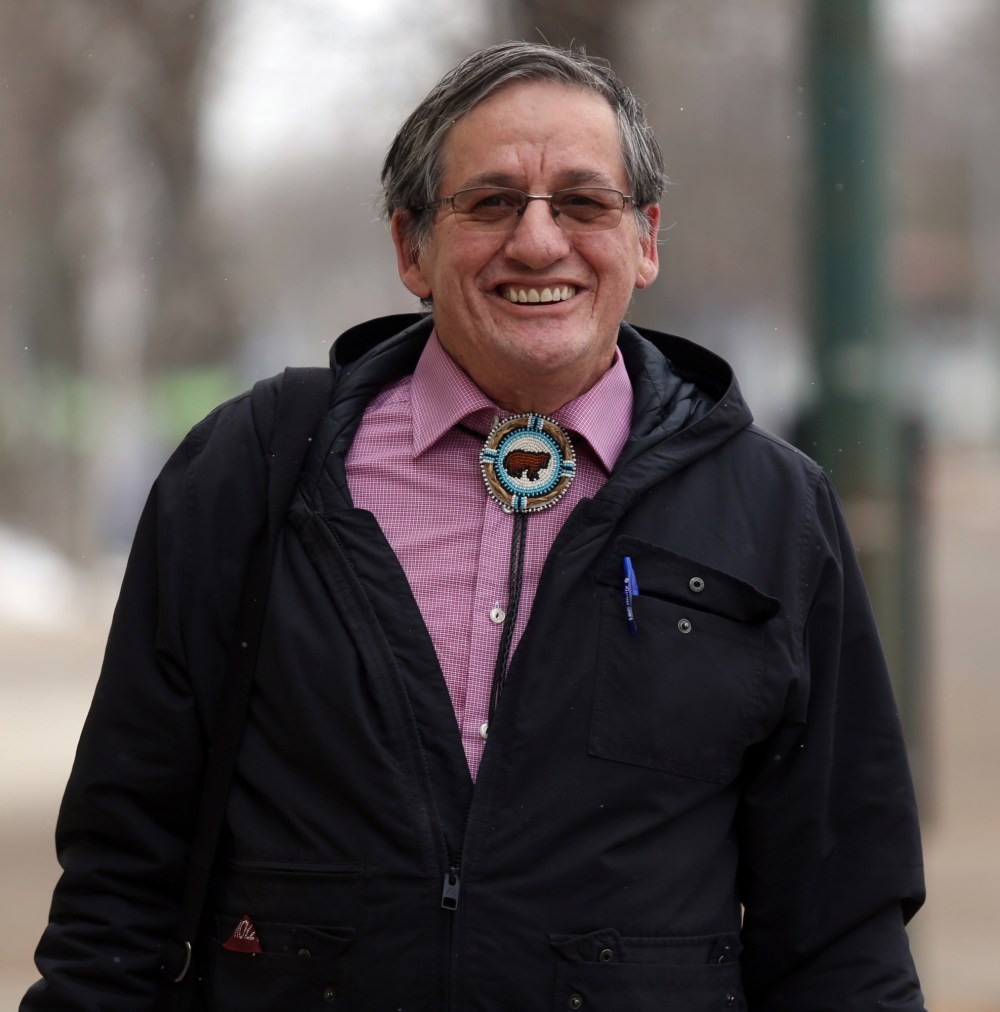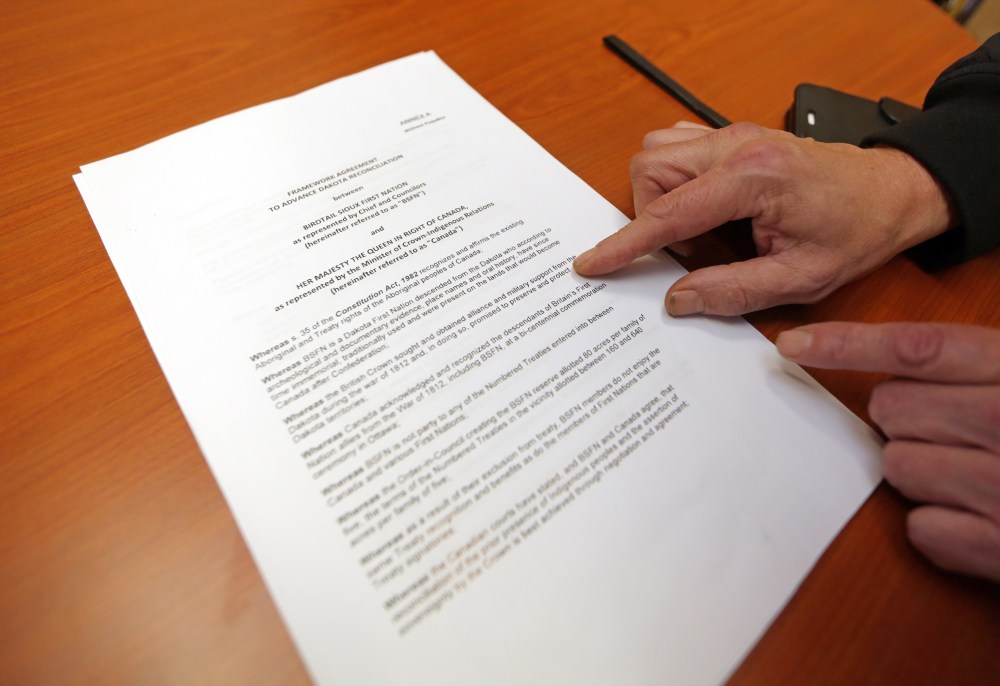Birdtail in treaty talks with feds
Advertisement
Read this article for free:
or
Already have an account? Log in here »
We need your support!
Local journalism needs your support!
As we navigate through unprecedented times, our journalists are working harder than ever to bring you the latest local updates to keep you safe and informed.
Now, more than ever, we need your support.
Starting at $15.99 plus taxes every four weeks you can access your Brandon Sun online and full access to all content as it appears on our website.
Subscribe Nowor call circulation directly at (204) 727-0527.
Your pledge helps to ensure we provide the news that matters most to your community!
To continue reading, please subscribe:
Add Brandon Sun access to your Free Press subscription for only an additional
$1 for the first 4 weeks*
*Your next subscription payment will increase by $1.00 and you will be charged $20.00 plus GST for four weeks. After four weeks, your payment will increase to $24.00 plus GST every four weeks.
Read unlimited articles for free today:
or
Already have an account? Log in here »
Hey there, time traveller!
This article was published 04/11/2019 (2164 days ago), so information in it may no longer be current.
For the first time since Confederation, members of the Birdtail Sioux First Nation (BSFN) may have a real shot at obtaining full treaty rights under Canadian law.
Chief Ken Chalmers revealed as much during a Friday morning conversation with the Sun, during which he presented a new framework agreement that was signed by then-Minister of Crown-Indigenous Relations Carolyn Bennett back in April.
In this document, the federal government concedes that members of BSFN, as descendants of the Dakota, “traditionally used and were present on the lands that would become Canada after Confederation.”

This statement represents an about face from the government’s previous position on the Dakota’s heritage, which maintained the idea that the Dakota people are “American refugees” and therefore not eligible for Aboriginal land rights in this country.
However, after years of talking with Chalmers and his associates, the government is now willing to, according to the framework, “explore and seek a mandate to negotiate a BSFN Core Treaty Relationship.”
While this document itself is not a treaty or legally binding, the objectives outlined in this framework involve helping this First Nation “realize its vision for self-determination.”
This includes addressing BSFN’s governance, infrastructure and socio-economic gaps that have popped up due to the roughly 150 years they’ve lived without a treaty.
As wards of the Crown, BSFN members were forced into much smaller tracks of land compared to typical treaty bands. According to Chalmers, this limited area does not give them enough space for economic development that would allow them to become self-sufficient.
The 61-year-old chief told the Sun that this new framework represents a good first step toward reconciliation and will hopefully lead to greater prosperity for his people down the line, especially since their land is rich in oil and potash.
“The big picture (for me) is getting my people healthy in safe homes, safe environments, good schools, good water, get them going, get them healthy, and I want to negotiate where we are in Canada,” he said.
In a Sunday afternoon email, Bennett’s office confirmed the legitimacy of this framework, stating that it serves as a foundation to “build a renewed nation-to-nation relationship and support Birdtail Sioux’s vision of self-determination.”
The statement concluded by saying: “This is an important step toward a lasting and meaningful reconciliation with Birdtail Sioux First Nation and a brighter future for their community.”
The marginalization of the Dakota people largely began when the group fought alongside the British in the War of 1812, Chalmers said.
Even though they were promised a permanent settlement for making this alliance, the English abandoned its Indigenous allies at the Treaty of Ghent signing in Belgium in 1814 that brought the conflict to an end.
Following the events of the Dakota War in 1862, the United States military drove some of the Dakota population into Canada, back to lands they had not given up. Yet they were forced to live on reserve lands in Manitoba and Saskatchewan.
By the time Confederation rolled around, the Canadian government didn’t give serious consideration to the Dakota people and never included them in the numbered treaty system that Indigenous groups are still sorted into today.
Thankfully, Chalmers said BSFN’s contribution to the War of 1812 was recognized in the recent framework, which strengthens his claim that the Dakota should be considered “nation builders.”
“‘Nation builder’ means we fought for this country,” he said. “(Without us) there wouldn’t be a Canada. We’d be … all American citizens right now if we didn’t fight in the War of 1812.”
Chalmers mentioned that former prime minister Stephen Harper was also pivotal in highlighting their contribution to the conflict, since he made a point of involving many Dakota First Nations in his government’s War of 1812 bicentennial celebrations back in 2012.
Of course, this recent framework isn’t the first time that the Dakota have sought to establish their place in Canadian society.
Back in 2007, the government rejected claims from Dakota and Lakota First Nations in Manitoba and Saskatchewan that they have aboriginal rights to land.
In 2009, Canupawakpa Dakota Nation, Sioux Valley First Nation and Dakota Plains First Nation filed another claim in federal court alleging that Canada misrepresented the Dakota people as “American Refugees” in the 1870s.
However, Chalmers chose not to involve BSFN in this case, claiming that this approach might ruin his First Nation’s pre-existing partnerships with the federal government. This decision caused a lot of friction between Chalmers and other Dakota members, with some even claiming that he was allowing the government to employ typical “divide and conquer” tactics on Indigenous groups.

Today, Chalmers claims he was playing the long game all along, since he didn’t want to relegate his people to a quick settlement that wouldn’t result in meaningful change.
The BSFN chief said he really started making inroads with the Canadian government back in 2015 when Prime Minister Justin Trudeau’s Liberal Party came to power.
This issue got a signal boost in 2017 when Liberal MP MaryAnn Mihychuk, who also served as a chair of the Standing Committee on Indigenous and Northern Affairs at the time, spoke publicly about how she was “surprised” and “appalled” when she learned how the Dakota were treated.
“The border is actually an artificial line that we as settlers put there,” she said back in December 2017, adding that Canada has long betrayed the goodwill of Indigenous people and that the current Liberal government is “committed to moving things forward, to speeding up the process.”
This sentiment carried over into the negotiations with BSFN, since Chalmers said the government representatives he dealt with offered very little in terms of resistance.
“I found there was no push back. They wanted to reconcile with us,” he said. “They understood the injustice and the discrimination by Canada and the U.S.”
As these negotiations move forward, Chalmers admits that he isn’t sure how this framework will affect the other non-treaty Dakota bands in Manitoba and Saskatchewan.
However, in a followup conversation with the Sun, Chalmers’ chief negotiator Dal McCloy said they would like to reach an agreement that benefits everyone.
“We’ve got to find some solutions to this without mucking the waters everywhere else,” McCloy said. “We’ve got to figure out some way to do this where everybody can come out happy.”
As it stands, Chalmers said talks with the federal government will resume sometime following Nov. 20, when Trudeau is supposed to officially name his cabinet members.
Until then, the chief remains cautiously optimistic about the future, since nothing in this framework is set in stone and a lot of details still need to be finalized.
“This (framework) is not saying we’ve got anything yet,” said Chalmers. “It’s all talk. It could all go to hell. We could end up with nothing or we could end up with a fantastic thing.”
Birdtail Sioux First Nation is located roughly 130 kilometres northwest of Brandon and comprises around 600 people.
Aside from BSFN, there are four other non-treaty Dakota bands located in Manitoba. They are Canupawakpa Dakota Nation, Sioux Valley Dakota Nation, Dakota Plains First Nation and Dakota Tipi First Nation.
» kdarbyson@brandonsun.com
» Twitter: @KyleDarbyson
